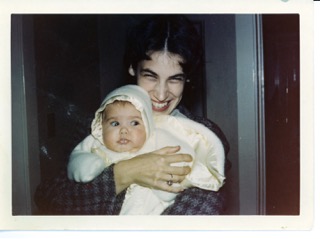The Dolly's Dress
Always make it a pair. When buying a bra, get the matching panty. When sewing a dress for a little girl, make one for her dolly, too.
Mom sat quietly in front of the sewing machine, the lamp shining brightly over her shoulder onto the tiny dress she held on her lap. A matching one, only slightly larger, already hung in a little girl’s closet, far away in Australia.
Mom turned the dolly’s dress inside out to inspect the waistline seam she had just sewn. She frowned and slowly pulled out each little stitch: something wasn’t right. This was for her first granddaughter. The dolly dress must match the girl’s dress perfectly.
Mom, Isabel, dress. Photo by Karen Dean.
My own sewing lessons ended abruptly years ago when I broke a fourth needle. Mom had, however, successfully taught me the satisfication of sewing—precision—particularly when attaching a full skirt to a fitted bodice. Each stitch must take in more fabric from the skirt than from the bodice, but it must do so invisibly. Begin by pinning the side seams to one another, then pin the center and the back of the skirt. Do not sew. A gathered seam must first be basted. Cut a long section of cheap thread and sew it first by hand. Squish, push, squeeze the fabric. Do not fold it: we are gathering, not pleating.
Once the dress was finished, she hung it on a tiny hanger next to her sewing machine, anticipating the dolly’s next visit. Mom refused to mail the dress, preferring to gift it in person so she could savor the delight it would elicit.
As the months passed, though, her cancer progressed. She could hardly walk by the time the little girl arrived, but in the middle of the international arrivals lounge, next to the luggage carousel, dolly was stripped and joyfully transformed into something quite perfect.
- After her mother’s death, Jerilyn Sambrooke took a renewed interest in sewing but has yet to master the fine art of a gathered skirt. Jerilyn currently lectures in the Rhetoric Department at the University of California, Berkeley. She is also working on a memoir, Alpenglow: A Year of Darkness, that narrates the year following her mother’s death. Her reflections on grief owe much to her academic research on religious practice and secular life in contemporary fiction.











![[figure 1]](https://images.squarespace-cdn.com/content/v1/5538e6a9e4b0c45515e4d503/1432237958488-WZBR2X146U6FYB35483C/LS+fig+1.jpg)
![[figure 2]](https://images.squarespace-cdn.com/content/v1/5538e6a9e4b0c45515e4d503/1432237973025-5LNSH6AOSJHOZ4CAVEKW/image-asset.png)